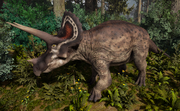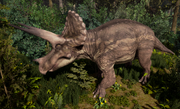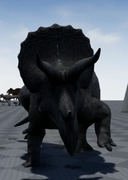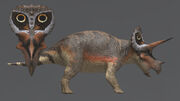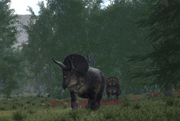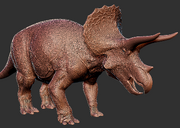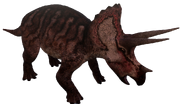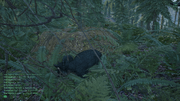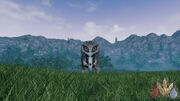Triceratops is a genus of chasmosaurine ceratopsians from the Late Cretaceous of North America. It has two species; T.horridus and T.prorsus.
Triceratops was added to The Isle in Patch 0.0.0.67.
In Real Life[]
Triceratops was one of the last ceratopsians, and at maximum size, it was 29 feet (9 meters) long, 9.8 feet (3 meters) tall and 6 tones in weight. The horns above their eyes were each 1 meter (3.3 feet) in length. The frill was relatively short and lacked any fenestrae, though some specimens have occipital's lining the frill's edge.
Triceratops likely lived in small family groups, and fed on ferns, palms, and cycads. They walked with the elbows bowed out, like a rhinoceros. In combat, it used its large brow horns to ward off predators such as Tyrannosaurus.
There is a decent amount of evidence to suggest that Triceratops used its horns in intraspecific combat, as many specimens have damage to the skull that is too localized to be the result of bone disease. The frill itself is also made of fibro lamellar bone, which heals quickly, and develops early in life; indicating the frill was primarily for display.
In The Isle[]
Although the Triceratops is very slow, even when sprinting, it is a very tough dinosaur even on its own. One attack can severely injure its foes. If fighting solo, it is best for it to face its opponent as its backside is very vulnerable to attacks.
When in a herd, staying vigilant is a vital element, herding up with other herbivores like Parasaurolophus or Gallimimus can help deter surprise attacks from predators. This keeps the chances of a herd being caught by surprise low. As most predators do not risk injuries hunting a Triceratops, aggressive display can help deter their approach and make chances of attack less common.
Most Triceratops defend the herd by forming a circle, keeping their backside safe and making it harder to be attacked, this method of defense can also be used to keep safe other neighboring herbivores. Such tactics make relationships with other dinosaurs beneficial as well as benefiting from alarm calls.
Triceratops is a very strong dinosaur that can take on almost any other apex. If players don't have the privilege of a herd an aggressive lifestyle can better benefit solo play.
General Information[]
Pros:[]
- Best Dinosaur for tanking after Spinosaurus.
- Extremely high Health, Damage and Bleed.
- Decent Turn Radius.
- Very Strong Stomp Attack.
- Good horn attack.
- Can break bones. (currently removed)
- Good bleed resistance.
- Easiest apex to grow in survival.
- Very short juvenile stage.
- Can overpower other apexes if given a chance.
- Large hitbox.
Cons:[]
- Slowest Dinosaur. (in Survival)
- Cannot stomp with a broken leg.
- Stomp is slow and prevents the Trike from turning during the animation, making it less useful when the attacker remains mobile during the fight.
- Very slow heal rate,
- Very long sub-adult stage makes it vulnerable to adult Apexes.
- As an adult, it does not regenerate stamina while walking.
- Its legs break very easily.
- Can be overpowered quite easily by other apexes.
Gallery[]
Behind the Scenes[]
- Triceratops will get a remodel in the future, with more curved horns.
- Trike Growth Morph can be downloaded here
- As of Devblog #33 and some confirmation from Kissen, Triceratops will be one of two apexes coming to the Evrima branch as playables but only on community servers.
| The Isle Archosaurs |
|---|
| Acrocanthosaurus • Albertosaurus • Allosaurus • Ankylosaurus • Apatosaurus • Austroraptor • Avaceratops • Baryonyx • Beipiaosaurus • Brachiosaurus • Camarasaurus • Carnotaurus • Ceratosaurus • Compsognathus • Corythosaurus • Deinosuchus • Diabloceratops • Dilophosaurus • Diplodocus • Dryosaurus • Gallimimus • Giganotosaurus • Herrerasaurus • Homalocephale • Hypsilophodon • Kentrosaurus • Magyarosaurus • Maiasaura • Megaraptor • Minmi • Monolophosaurus • Orodromeus • Pachycephalosaurus • Pachyrhinosaurus • Parasaurolophus • Plateosaurus • Protoceratops • Psittacosaurus • Pteranodon • Puertasaurus • Quetzalcoatlus • Shantungosaurus • Spinosaurus • Stegosaurus • Styracosaurus • Suchomimus • Tenontosaurus • Therizinosaurus • Triceratops • Troodon • Tyrannosaurus • Utahraptor • Velociraptor |

